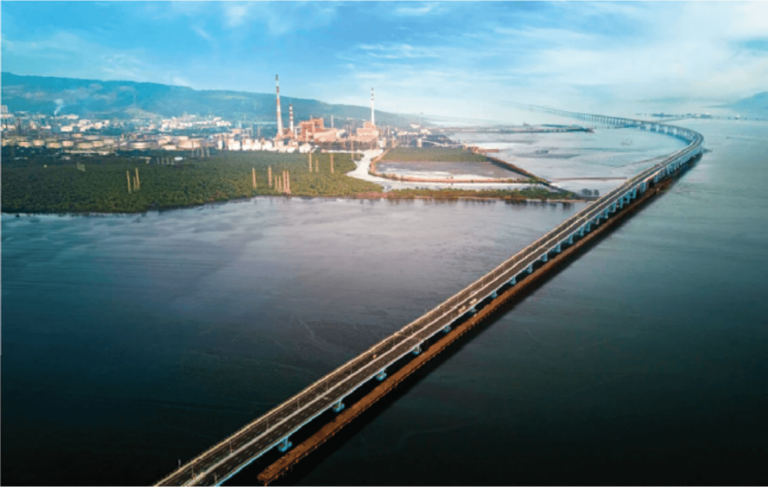Gajanan Khergamker narrates how the 22-kilometer-long marvel of engineering, inaugurated by PM Modi stands not just as a symbol of advancement and growth but also prides itself on its eco-friendly attributes, putting it on par with the world’s finest bridges. Standing tall at a towering height of 100 meters, it not only claims the title of India’s longest sea bridge but also stands among the world’s tallest cable-stayed bridges.
Mumbai, renowned as the city of aspirations, famed for its lively pace of life, bustling thoroughfares, and renowned landmarks, recently welcomed a significant addition – the Atal Bihari Vajpayee Sewri-Nhava Sheva Atal Setu.
On 12 January 2024, Prime Minister Narendra Modi inaugurated India’s lengthiest bridge, linking Sewri in Mumbai to Nhava Sheva in Uran Taluka of Navi Mumbai.
This 22-kilometer-long marvel of engineering stands not just as a symbol of advancement and growth but also prides itself on its eco-friendly attributes, putting it on par with the world’s finest bridges.
During the event, PM Modi fondly reminisced about his ‘dear friend’ Shinzo Abe following the inauguration of the Mumbai Trans Harbour Link (MTHL) or Atal Setu, crediting the former Japanese PM for envisioning the project alongside him.
Addressing the audience after inaugurating India’s longest sea bridge, the Prime Minister expressed gratitude to the Japanese government for its support in bringing the project to fruition. “Today, I wish to recall my dear friend, the late Shinzo Abe. Both of us were committed to completing the Mumbai Trans Harbour Link project,” he said.
The six-lane cable-stayed Atal Setu, stretching over 22 kilometers, is crafted to accommodate heavy vehicular traffic between these vital commercial zones in Mumbai. Its distinctive curved design sets it apart, making it a visually captivating structure amidst Mumbai’s bridge network. Standing tall at a towering height of 100 meters, it not only claims the title of India’s longest sea bridge but also stands among the world’s tallest cable-stayed bridges.
Low environment impact
Atal Setu’s environmentally conscious design is one of its most prominent features. Every detail of the bridge’s construction has been carefully planned and executed to minimise its impact on the surrounding ecosystem. This includes using sustainable materials and implementing measures to reduce noise pollution.
The bridge’s construction incorporates high-strength concrete with a lower carbon footprint compared to traditional concrete. This not only enhances the bridge’s durability but also helps in reducing carbon emissions, contributing to environmental sustainability. Additionally, solar panels installed on the bridge deck harness solar energy, reducing reliance on traditional energy sources and promoting renewable energy usage.
Furthermore, Atal Setu is equipped with cutting-edge technology, setting it apart from other bridges in India. An intelligent transportation system, consisting of sensors, cameras, and automated toll collection systems, ensures smooth traffic flow and enhances overall efficiency. Moreover, an advanced monitoring system constantly monitors the bridge’s structural integrity, promptly alerting authorities to any irregularities or potential issues.
Designed to withstand natural disasters such as earthquakes and cyclones, Atal Setu showcases India’s technological expertise and resilience. It not only represents progress but also demonstrates the nation’s ability to overcome challenges and build infrastructure that can withstand adverse conditions.
Transforming landscapes
The completion of Atal Setu marks a significant milestone not only for Mumbai’s skyline but also for its economic landscape. By connecting Sewri to Nhava Sheva and drastically reducing travel time from two hours to just 20 minutes, the bridge is poised to revolutionise trade, commerce, and local employment opportunities in the region.
Moreover, Atal Setu’s environmentally friendly design is expected to attract tourists from around the world. Offering breathtaking panoramic views of Mumbai’s skyline, the bridge solidifies the city’s status as a premier tourist destination.
Beyond its functional role as a bridge, Atal Setu symbolises India’s journey of progress and development. With its fusion of advanced technology, eco-conscious design, and striking aesthetics, the bridge stands alongside the world’s finest structures, showcasing India’s engineering prowess on a global stage.
Not only does Atal Setu improve commuters’ lives, but it also contributes to Mumbai’s evolution into a truly world-class city. Setting a new benchmark for infrastructure projects in the country, the bridge’s eco-friendly features and advanced technology mark a proud moment for India and a step towards a greener, more sustainable future.
Modern and marvellous
India’s infrastructure development efforts, exemplified by projects like the Delhi-Mumbai Industrial Corridor, the Mumbai-Pune Expressway, and the Golden Quadrilateral Highway network, have garnered international recognition. Atal Setu adds to this legacy, underscoring India’s commitment to modernisation and progress in the realm of infrastructure development.
While it may not hold the record for the longest sea bridge in the world in terms of length, Atal Setu’s engineering techniques and its ability to overcome challenges in constructing a bridge over a vast water body are truly commendable.
During the bridge’s construction, special attention was paid to its potential impact on the environment, particularly on aquatic life and flamingos inhabiting Thane Creek. Strict guidelines were followed, including the installation of special foundations and limiting construction activities during peak migratory bird seasons, to minimise disruption to the delicate ecosystem.
Advanced engineering techniques, including the use of advanced materials and precision engineering, were employed to address concerns about collapse and pollution. These efforts ensured that the bridge remains stable even during adverse weather conditions, aligning with India’s commitment to sustainable development.
Futuristic development
India has taken proactive steps towards environmental conservation through the implementation of various policies and regulations. Initiatives such as the Clean Ganga mission, aimed at rejuvenating the River Ganges and promoting its cleanliness, and wildlife conservation programmes like Project Tiger, designed to protect endangered species and their habitats, underscore the country’s dedication to sustainable development and environmental protection.
The construction of Atal Setu has played a significant role in advancing India’s environmental goals. By improving transportation efficiency and reducing travel time between Sewri and Nhava Sheva, the bridge has contributed to a substantial decrease in the region’s carbon footprint. This reduction is attributed to lower fuel consumption and emissions from vehicles, resulting in improved air quality and environmental health.
India’s commitment to renewable energy and low-carbon transportation systems further reinforces its dedication to environmental sustainability. By focusing on renewable energy sources such as solar and wind power, as well as developing low-carbon transportation alternatives, India aims to reduce its reliance on fossil fuels and mitigate the adverse effects of climate change. This strategic approach aligns with the country’s broader goal of achieving sustainable development while fostering economic growth.
India’s implementation of environmental policies and regulations, coupled with initiatives like Atal Setu, reflects its proactive stance towards environmental conservation and sustainable development. By prioritising renewable energy and adopting low-carbon transportation systems, India strives to strike a balance between economic progress and environmental protection, paving the way for a greener and more sustainable future.
The propaganda
Following the inauguration of Atal Setu, there were reports of criticism from foreign media, which lacked factual basis and seemed politically motivated. Such criticisms have been evident in the past as well, indicating a tendency to discredit India’s infrastructure development achievements.
The construction of Atal Setu is part of India’s broader infrastructure expansion efforts, aimed at modernising the country’s transportation network, reducing congestion, and promoting economic growth.
Criticism from certain quarters, including think tanks from distant locations such as Philadelphia, seems to overlook the technological advancements incorporated into the bridge’s design to address present-day concerns and anticipate future challenges.
Despite initial concerns about the bridge being constructed exclusively for affluent private vehicle owners, the toll charges for its use are justified by the need to repay loans from international agencies and are in line with charges for similar infrastructure projects elsewhere in India.
Every action, including the construction of Atal Setu, has its consequences, but its positive impact on connectivity, emissions reduction, and overall development cannot be ignored. As India continues its journey towards progress and sustainable development, Atal Setu stands as a testament to the nation’s determination and resilience.


 Gajanan Khergamker is an independent Editor, Solicitor and Film-maker. He is the founder of the International Think Tank DraftCraft
Gajanan Khergamker is an independent Editor, Solicitor and Film-maker. He is the founder of the International Think Tank DraftCraft